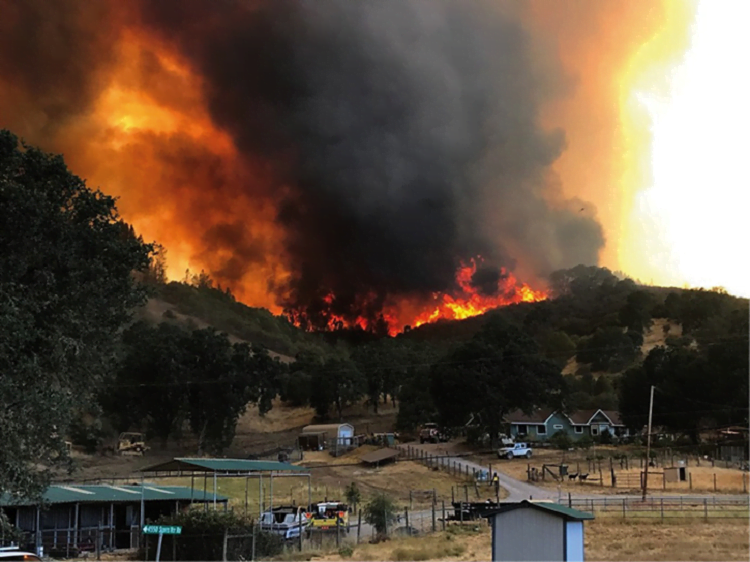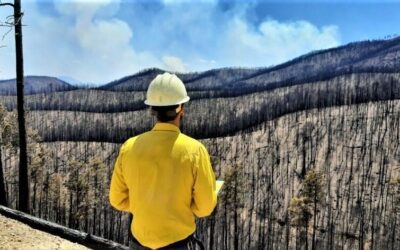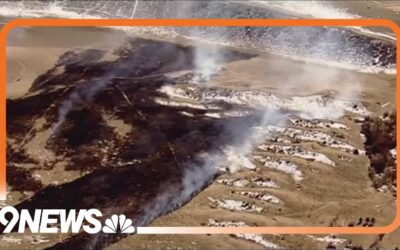Being in the weeds isn’t a desired position

(Photo by Trevor Steis)
Chad Costa | Fire Engineering
Over the past five years, California has experienced many catastrophic wildfires. These fires have spread at an unprecedented rate. This article will discuss how to lead as a member of the operations team during a rapidly growing wildfire.
My Experiences
In 2018, I responded for immediate needs as a division group supervisor for the River Fire in Mendocino County. Both the River and Ranch Fires ignited in the same geographical area and quickly grew out of control. Both of those fires eventually became the Mendocino Complex, which burned hundreds of thousands of acres. Although the River Fire was within an adjoining county, I did not have a solid understanding of the fire’s landscape. This is common; many times, we respond to fires outside of our local jurisdiction.
On arrival at the River Fire, I was assigned a division on the fire’s right flank. The fire was already a couple of hundred acres. While driving around and establishing a plan, I came across a local fire captain. It became apparent that this fire captain was extremely knowledgeable of the area; this was his local district. I asked him to ride around with me and help increase my situational awareness. (If given the opportunity, take advantage of any local knowledge that you can find. This could be from a local firefighter, a firefighter on one of your engines, or just a local citizen who lives in the area. Many times, you will find ranchers or other residents who are willing to give you needed information. Whether it be a local weather pattern, topography, or fire history, local knowledge is extremely helpful and beneficial to your success.)


(1, 2) A view of the Bennet Valley area during the Nuns Fire. (Photos by Kevin Burris.)

(3) An evacuation zone map of the Kincade Fire using Avenza Maps®. (Photo courtesy of MAPublisher®.)
In 2019, during the Kincaid Fire in Sonoma County, I found myself responsible for a large geographical area. The fire was growing rapidly and overwhelming our resources quickly. As it spread from a rural area into a community, I found it impossible to manage every portion of the branch. To be successful, I needed to establish additional subordinate leadership. Along with the division supervisors, there were strike team leaders with whom I had worked in the past and strike team leaders who worked in this local area. Using additional subordinate leadership and establishing subordinate supervision throughout your division or branch are extremely important; these fires can overwhelm us quickly. Once you recognize you have a leader who is capable and competent in handling one of your tasks, assign that task to him immediately and ensure that everyone in this area is aware of your delegation. Delegating tasks to competent and capable leaders will help you focus on the bigger picture and ensure that you don’t end up behind the curve.
Simply thinking ahead is not enough during these incidents. Supervisors must always think two to three steps ahead. It is important to identify your control objectives. Many times, we set an objective of holding a fire at a certain road or geographic location. However, with the new normal, we must realize our probabilities of success at holding the fire at that geographic area. Again, during the Kincaid Fire, we attempted to stop the fire at multiple geographic locations. However, in this fire environment, the probability of stopping the fire was low. With knowing the low probability of success, it was imperative that we were prepared for the inevitable. Communicating where the fire is, where it’s going, and where it will probably end up is extremely important during these fast-growing incidents. As leaders, we must ensure that we do not get the “candle moth syndrome” and focus solely on the fire’s edge. Using our cooperators and fire resources, we must continually think about contingency and preparation in areas where the fire may end up. Focusing solely on the fire’s edge may put you behind the curve.
Before the Wildfire
Preparing yourself to lead during the new normal should start prior to fire season. Prior to the incident, set yourself up for success. In the spring, go through your gear and supplies and ensure that you have everything you think you may need. Division supervisors and branch directors need the tools that allow them to carry out their jobs successfully. Technology is the most important tool; it is especially important to have a cell phone and a tablet that have mapping and global positioning systems (GPS) capabilities. The higher you are on the incident command system (ICS) structure, the more important technology and communication capabilities become. You will find yourself charging your phone multiple times in a shift because of the incredible amount of communication needed with your supervisors and adjoining forces.

(4) View of the Kincaid Fire from the Geyserville, California, area looking to the hills above the community. (Photo by author.)

(5) My strike team doing structure defense on the Detwiler Fire in Mariposa, California. (Photo by author.)
Having preplans and maps (topographic and street) at your fingertips improves your situational awareness. These tools are important when fires are growing rapidly or start during the nighttime hours. For example, electronic or digital maps are a great tool that allows for GPS and mapping capabilities. When responding to a wildland incident, supervisors should be downloading as many maps as possible; knowing the streets and topography will keep you ahead of the curve.
In conjunction with electronic maps, if available, ensure you have hands-on incident paper maps. You can display large paper maps easily on the side of your vehicle or hood when giving briefings or descriptive assignments. Also, as was taught to me by one of my trainers, carry highlighters and colored pencils to highlight roads and geographical landmarks to identify and explain your plan or needs to incoming or transitioning resources.
Next, have two portable radios in your cache. During these fast-moving wildfires, you can find yourself monitoring multiple channels. Having your mobile radios on tactical and command channels and your portables monitoring air to ground and your adjoining forces will ensure that you do not miss important incident traffic.
Prepare for 24 to 36 hours of consistent work. Stock your vehicle with food, water, and additional supplies you may need during these extended events. It’s not uncommon to go eight to 12 hours without eating during these responses. The intensity of these events and the amount of pressure and focus needed often lead to forgetting about taking care of yourself. Having these important supplies at your fingertips will remind you to take care of yourself because time can fly by.
Communicating Early in the Incident
Understanding the mission, priorities, and control objectives is important during these incidents. During the initial stages of a wildland fire, the mission, priorities, and control objectives may not be established. Supervisors must establish them immediately and relay them up and down the chain of command. Among the chaos, the leader’s intent will drive the subordinate leaders’ actions. However, the sooner the priorities, control objectives, and overall mission are established, the sooner you will limit the chaos.
Offer suggestions on tactics. Remember, many of the firefighters responding may be unfamiliar with these catastrophic fires. They may be in a new situation and need your guidance with risk analysis in determining tactics. Do not be a micromanager; “being in the weeds” isn’t a desired position. However, when you notice hesitation, don’t be afraid to give suggestions or direction.
Next, stay mobile and know your geographical areas of responsibility. During these fast-growing incidents, your area of responsibility may be large. It can be extremely difficult to carry out the mission when you’re unsure of exactly what you’re dealing with. Stay mobile, and take the time to get a look at the area for which you are responsible.
One common mistake of supervisors in these situations is that they forget about face-to-face communication. Remember, the people working for you may not know who you are. They may have to refer to the incident action plan to find out your name or maybe just know you as your identifier. Taking a moment to stop and talk to your subordinate leadership can be extremely beneficial in gaining trust and respect. Many times when I’ve taken the time to stop and talk to subordinate leaders, I found that they had important information that helped me either validate my plan or make me rethink my plan.
Communication over the radio is important but, in general, keep it quick and to the point. Radio traffic is often overwhelming; at times, it can be difficult to get a word in. This reinforces the point that stopping to have face-to-face communication is key.
You may feel like you don’t have enough resources. Communicate your resource needs to your supervisor. Remember, the operations team is relying on you to feed them with important “boots on the ground” information. At the command post, they’re relying on you to validate their plan or suggest improvements to their plan. Many times, how things are perceived at the command post may not actually reflect what’s happening out in the field.

(6) View during the Tubbs Fire in Coffey Park in Santa Rosa, California. (Photo by Trevor Steis.)

(7) View of the Mendocino Complex off Scotts Valley Road near Ukiah, California. (Photo by Trevor Steis.)
Communication with your supervisors on resource needs and pertinent incident information is one of your most important responsibilities. Conditions change rapidly in this environment, so you may need to adjust plans rapidly. Your leadership is relying on you to ensure that the overall mission and leaders’ intent is being carried out. If you do not communicate with them and ensure that they know the current update and situation along with other needs, it is highly probable that the plan and mission will not be aligned with your tactics and strategy. Clear, direct, and to-the-point communication as well as your resource needs and plan will help the leaders at the command post support you.
As previously mentioned, communication can be difficult during these incidents. Radio traffic can be nonstop to a point where it can be difficult to find breaks in that traffic for your transmission. So, ensure that radio traffic is pertinent and necessary to the immediate actions and conditions. Many times, I’ve found myself getting frustrated with nonessential radio traffic. As soon as this occurs, set clear expectations on radio traffic. A quick reminder to all your subordinate leaders will help curb this nonessential traffic.
Also, remember to communicate clearly and directly. Take a deep breath and think about what you’re saying. You set the tone for your division or branch. If you find yourself getting excited or starting to raise your voice, stop and take a breather. Your subordinate leaders will follow your command presence, so stay cool, calm, and collected.
Communicating with your subordinate leadership and adjoining forces is extremely important during these incidents. These fires grow so rapidly that it’s impossible to keep up with the fire perimeter. Using your subordinate leadership and adjoining forces as additional eyes will help you evaluate the success of your plan.
Being the Leader
During these incidents, you will find yourself among the chaos. As a leader, ensure that you’re giving clear direction. Once you’ve established and communicated your priorities and given out assignments, continually evaluate and reinforce your priorities and objectives.
And, among this chaos, you will come across firefighting tactics that aren’t aligned with your overall mission. When this occurs, stop what you’re doing immediately and reinforce your priorities.
Conversely, these fires are extremely stressful and physically and mentally exhausting. Take care of your people and ensure that their efforts and successes are recognized. This could be a simple acknowledgment through the radio or a quick kudos given to a subordinate leader.
These incidents can be life changing for everyone, so be cognizant and respectful of the acute and long-term effects on your team, and take every opportunity you can to ensure they are taken care of. This can still be true long after the incident is mitigated. After all, we are all family and should be treated as such.
CHAD COSTA is a 20-year fire service veteran and a battalion chief with the Petaluma (CA) Fire Department. He has worked in multiple organizations including the California Department of Forestry and Fire Protection (CAL FIRE), rural and semi-rural districts, and a city. Costa is also the technology and communications battalion chief and a division group supervisor on California Interagency Team 5. He has a bachelor’s degree in emergency services management and a certificate in homeland security.




